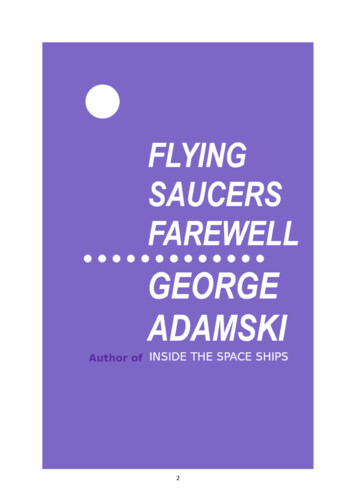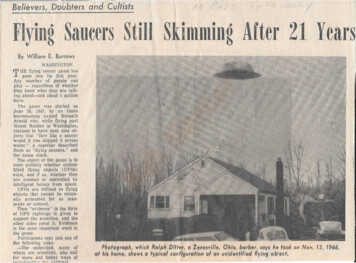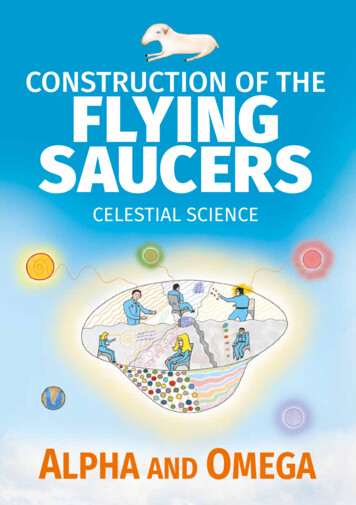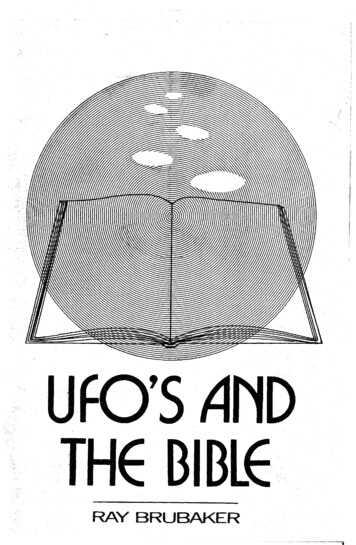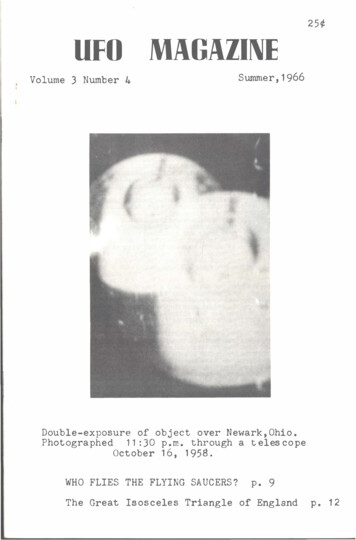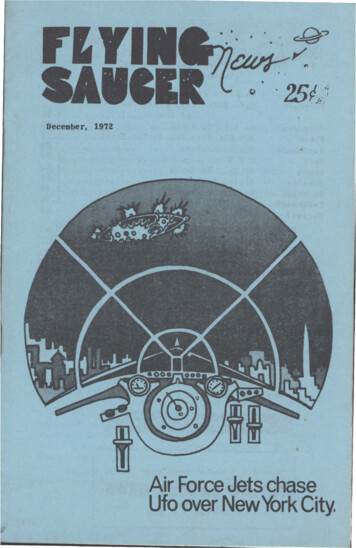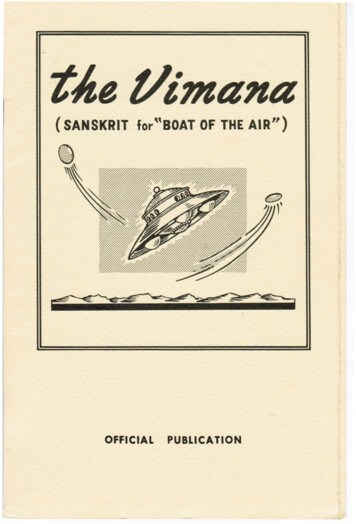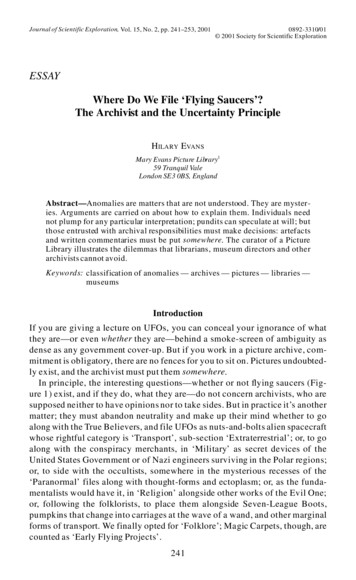
Transcription
Journal of Scientific Exploration, Vol. 15, No. 2, pp. 241–253, 20010892-3310/01 2001 Society for Scientific ExplorationESSAYWhere Do We File ‘Flying Saucers’?The Archivist and the Uncertainty PrincipleHILARY EVANSMary Evans Picture Library159 Tranquil ValeLondon SE3 0BS, EnglandAbstract—Anomalies are matters that are not understood. They are mysteries. Arguments are carried on about how to explain them. Individuals neednot plump for any particular interpretation; pundits can speculate at will; butthose entrusted with archival responsibilities must make decisions: artefactsand written commentaries must be put somewhere. The curator of a PictureLibrary illustrates the dilemmas that librarians, museum directors and otherarchivists cannot avoid.Keywords: classification of anomalies — archives — pictures — libraries —museumsIntroductionIf you are giving a lecture on UFOs, you can conceal your ignorance of whatthey are—or even whether they are—behind a smoke-screen of ambiguity asdense as any government cover-up. But if you work in a picture archive, commitment is obligatory, there are no fences for you to sit on. Pictures undoubtedly exist, and the archivist must put them somewhere.In principle, the interesting questions—whether or not flying saucers (Figure 1) exist, and if they do, what they are—do not concern archivists, who aresupposed neither to have opinions nor to take sides. But in practice it’s anothermatter; they must abandon neutrality and make up their mind whether to goalong with the True Believers, and file UFOs as nuts-and-bolts alien spacecraftwhose rightful category is ‘Transport’, sub-section ‘Extraterrestrial’; or, to goalong with the conspiracy merchants, in ‘Military’ as secret devices of theUnited States Government or of Nazi engineers surviving in the Polar regions;or, to side with the occultists, somewhere in the mysterious recesses of the‘Paranormal’ files along with thought-forms and ectoplasm; or, as the fundamentalists would have it, in ‘Religion’ alongside other works of the Evil One;or, following the folklorists, to place them alongside Seven-League Boots,pumpkins that change into carriages at the wave of a wand, and other marginalforms of transport. We finally opted for ‘Folklore’; Magic Carpets, though, arecounted as ‘Early Flying Projects’.241
242H. EvansFigure 1Figure 2If you work in a picture archive, such decisions recur with disturbing frequency. Soon you begin to wonder if you know anything for certain about theworld you live in. Though you’ve made your decision about flying saucers,you can’t relax: you must decide what to do about Crop Circles (Figure 2).Well, crop circles are ‘Natural Phenomena’. Yes, I know what you’re going tosay, but how can we separate the genuine from the hoaxes, when even the experts are fooled?Then, where will you put the Loch Ness Monster and Sea Serpents (Figure3—we opted for ‘Folklore’ subsection ‘Creatures of the Water’)?How are you to classify this strange blue light hovering over a sleeping Italian lady (Figure 4—Anna Monaro’s famous 1934 case is classified as ‘Anomalous Luminous Phenomena’)?And what about those somnambulists who walk so serenely on perilousrooftops (Figure 5)? Or Fairy Godmothers?Fortunately, the Uncertainty Principle is something that picture archivistslearn to cohabit with fairly early in their career (Figure 6—‘Concepts:Chance’; an Italian housewife finds a gold Napoleon coin in a freshly gatheredpotato). Even if your Fairy Godmother (Figure 7—look for Fairy Godmothersin ‘Myth & Legend’) neglected to bestow on you the gift of Skepticism at yourChristening (Figure 8—‘Customs: Baptism’), your work among illustrationswill soon thrust it upon you. Le Chien de Montargis, for example, that dog whofamously identified the murderer of his master and worsted him in a duel (Figure 9—‘Famous Dogs’; see also ‘Dogs of the Famous’); or Charlemagnesleeping in his tomb at Aix-la-Chapelle, ready to save France in her hour ofneed—historical fact or genial fiction? (Figure 10—‘Myth: France’)Is there, indeed, a single picture in our files which faithfully depicts thescene as it actually occurred—that is, if it occurred? If you and I had been onthe spot to witness Giuseppe di Cupertino levitating (Figure 11—‘Paranormal:Levitation’) or Therese Neumann weeping blood on every Good Friday (Figure 12—‘Paranormal: Stigmata’), would we have seen what the artist shows
Where Do We File ‘Flying Saucers’?Figure 3Figure 4Figure 5Figure 6243us? It is not at all certain. But then, should we put any more trust in photographs? Those photos of spirit mediums exuding yukky gunge—ectoplasm—from their private parts (Figure 13—‘Paranormal: Mediumship: Materialisation’)—would we have seen it if we had been present? And whatMargery Crandon produced with such heaving and straining from her intimateorifices in the 1920s, a child of seven could now create with computer software effortlessly and painlessly.Such puzzles lead to profound meditations on the Nature of Things. What isTruth? For example what about the Biblical Deluge (Figure 14—‘Religion:Bible Events’), which may recall the real flooding of the Black Sea? Assuredlyone would not find the answer in a Picture Archive. We do not questionwhether Paul Revere really roused supporters of independence along the road
244H. EvansFigure 8Figure 7Figure 9Figure 10to Lexington, and we dutifully file it as historical fact, stifling any doubts wemay have as to how much the legend as we have it may have been dictated bypolitical opportunism (Figure 15—‘Events: America’). But do we believe inrevenants from the past or phantasms of the living? Our illustrators certainlydo, and though ghosts are notoriously camera-shy, a few have been caught onfilm in equivocal circumstances (Figure 16—‘Paranormal Apparitions: Raynham Hall’: figure not seen but unwittingly photographed, possibly DorothyWalpole aka ‘The Brown Lady’). How is a humble archivist to resolve a question which has puzzled philosophers and metaphysicians for two thousandyears and looks well set to perplex them for as many more?Frankly, working in a picture archive does not generate much respect for
Where Do We File ‘Flying Saucers’?Figure 11245Figure 12Figure 14Figure 13Man the Historian; on the other hand, it gives one a great admiration for Manthe Mythmaker. Flying Saucers are only the latest of his achievements of thiskind: long ago there was Noah’s Ark (Figure 17—‘Bible Events’) of which wehave countless representations in our files. Ah, but in every picture the vessel isa different shape of which only one, at most, tells us what the Ark was reallylike. But which one?More recently, in the spring of 1904, Le Petit Journal excitedly told its readers that two Americans had successfully flown a heavier-than-air flying machine (Figure 18—‘Transport: Flight’). The picture is lovely, but if you’replanning to build a replica, don’t use this particular illustration as your blueprint and if relatively recent artists get the Wright biplane wrong, how canwe trust older artists’ depiction of the Ark?
246H. EvansFigure 15Figure 16Figure 17Figure 18 Or Cosmic Tricksters?It becomes easy to believe that this chaos is a deliberate machination by theCosmic Trickster (Figure 19—‘Folklore Entities’). The security for which weall yearn is not necessarily a blessing. It leads to stagnation; it stifles speculation. If we knew what flying saucers were, they would be as boring as automobiles—a momentary flicker of excitement when the Pleiadeans produce a newmodel for 2001, a turn of the head when a Martian Mother Ship passes overhead with one of the new Hyper-Space Time-Warp Turbines, but not the oldexcitement generated by les apparitions de Martiens in the lavender fields ofValensole. Our wonderful collection of American fantasy pulps from the gold-
Where Do We File ‘Flying Saucers’?Figure 19247Figure 20en era of Hugo Gernsback or popular images of saucers from the 1950s (Figure20—Flying saucer at Coulommiers, France in October 1954) is infinitely morepicturesque than the unimaginative blobs of light, or at best a domed DaylightDisk or cigar-shaped Mother Ship, in our UFO files. Now that anyone can create a fake UFO photo without leaving the computer, perhaps picture editorswill realise the far greater value of artists’ interpretations: our contributingartist Michael Buhler, who specialises in UFO art, is a long-standing and wellinformed ufologist who studies each case thoroughly before painting it.So it’s not something to complain about, when we come across a woundedFrench poilu from World War One being saved by a visionary Therèse deLisieux (Figure 21), and have to stop and think where to file it; in fact we havecreated a file for ‘Apparitions of World War One’, there were so many! Suchdocuments are not simply faits divers: or rather, yes, they are indeed faitsdivers, but they are a reminder that we must not make the mistake of supposingthat faits divers are momentary trivia, to be forgotten together with yesterday’sheadlines. Political scandals and financial shenanigans come and go, butphantom hitchhikers, spirits of the dead and babies being carried off by eaglesare with us for ever.Indeed, these seemingly marginal items are valuable clues to the culturalclimate which considers them worth preserving. When we see Sainte Therèsedoing her bit in the World War One trenches, that tells us something about thestate of faith in 1915, as do the Angels of Mons and Jeanne d’Arc (‘Joan of ArcRides Again!’—what a great movie title!) leading the French to death andglory on the Somme (Figure 22). Jokes about the first one-piece bathing dresses tell us something about moral attitudes of a period when nudity was permitted on the American stage (we have photos to prove it!); similarly a pamphletencouraging Frenchwomen to have more babies tells us something about the
248H. EvansFigure 21Figure 22Figure 23unstoppable French belief that population growth is equivalent to La Gloire(Figure 23—‘Community: Population’: Papa is exhausted through having towork so hard, but Maman is delighted). Our ‘Community: Population’ file hasa whole sub-section for French postcards of babies being born in cabbagefields and the like. If you prefer the Stork Theory, you will find that this, too, iswell represented, along with other interesting alternatives to the orthodox theories as to how the human species is replenished.Such trivia are history as it was lived, and we have no hesitation in housingthem alongside the battles, treaties and assassinations which are the stuff ofconventional history books. But they compel the archivist to recognise that theline between historical fact and folklore is impossible to draw. Paul Revere’sride, King Alfred burning the cakes, the Black Hole of Calcutta: we have themall filed as historical fact, but our tongue is firmly in our cheek as we do so. Theeminent French folklorist Veronique Campion-Vincent visited us once for aguided tour: at the end of her visit we agreed—our archive is all folklore. Or Martians?Every picture tells a story, and often a very different story from the one itscreator intended. It’s very instructive, for instance, to see what our grandparents thought the future would be like. Jules Verne was only one of many writers who anticipated our landing on the Moon: H G Wells was not the only oneto warn that the Martians might invade us. Our mind-boggling collection ofscience-fiction from the past tells us that there is hardly anything we can imagine today that our grandparents didn’t imagine fifty or a hundred years ago(Figure 24—‘Science: Inventions’: in 1899, the classroom of the year 2000would be fitted with teaching machines). Flying saucers? Yes, and their occupants—for in those days, every planet in the solar system was inhabited
Where Do We File ‘Flying Saucers’?249Figure 24Figure 25And here we encounter another dimension to the philosophical dilemma.Wells and his fellow authors could be rather vague in their textual accountsabout the appearance of their Martians or their Selenites; not so the artistswhose job was to illustrate their works. They had no choice but to visualise theMartians.Today, you can ask schoolchildren to draw you an extraterrestrial, and eventhough they have never personally encountered one, of course they will oblige.One is reminded of the schoolboy who did a drawing in class. His teacher askshim what it’s meant to be. “It’s a picture of God.” “But nobody knows whatGod looks like,” says the teacher. “They do now,” replies the young artist.What he draws is no more, but no less ‘true’ than our diverse images of God, orhis son Jesus, or the Evil One for that matter (Figure 25—‘Religious Concepts: Sacred Imagery’: ‘Folklore: Demons’).And here’s another thought to provoke philosophical meditation: if youwere to ask me to name which, of all the people we have pictures of in our files,is the one most likely to be recognised worldwide, I would choose, not Lincolnor Napoleon, not Charlie Chaplin or Mozart, not Jesus of Nazareth or AdolfHitler (Figures 26–31), but someone who never existed: Sherlock Holmes(Figure 32)—though see, in that respect, the wonderful tour-de-force of JeanDutourd, Les memoires de Mary Watson, in which Holmes is presented as a“real” person).All those famous names have attained the status of myth: we have Napoleonvisited by his personal ‘demon’, and in our ‘Hitler’ file, for example, you maysee that he is alive and well and living in Argentina Of course, in a certainsense, Sherlock Holmes did (and does) exist. But if we admit as much, can wesay that flying saucers, or the yeti, or levitating saints, are any less real? Sohere we are again, straddling the boundary between fact and fiction.
250H. EvansFigure 26Figure 27Figure 28Figure 29Figure 30Figure 31
Where Do We File ‘Flying Saucers’?Figure 32Figure 34251Figure 33Figure 35 Or Baby-Snatching Eagles?I am assured, by people who know what they are talking about, that wolvesdo not attack humans, and that an eagle is not physically capable of carrying asmall child. Yet we have a substantial file of wolves attacking people (Figure33), and quite a few eagles flying away with babies in their talons (Figure 34—names, dates and locations provided). Historical truth or journalistic imagination? Perhaps once there really was a little country girl who went through thewoods to visit her grandmother wearing a red riding-hood (Figure 35; for thetime being, though, Little Red Riding-Hood is in ‘Fairy Tales’). After all, herencounter with the wolf is easier to believe than Rosa Lotti’s 1954 encounterwith the two little Martians as she walked through the wood to Sunday Mass (Figure 36). This is one of the most famous images in UFO history, and should
252H. EvansFigure 36Figure 37Figure 38Figure 39be totally unbelievable. Yet Rosa, a pious Italian farmer’s wife, reaffirmed thetruth of her 1954 encounter, backed by her loyal husband who insisted shewould not lie about such a thing.Working in a picture archive teaches you there is nothing new under the sun,and that our generation no more invented disinformation, cover-up and revisionism than we invented the bikini (Figure 37—a female bull-baiter of ancient Crete wears the skimpiest of costumes, filed under ‘Sport with Animals:Bullfighting’) or the computer (Figure 38—our favorite computer picture, a‘Thought Machine’ from a 1927 ‘Amazing Stories’: it is the size of a doubledecker bus, and even so probably doesn’t include Solitaire ) or alien abduction(Figure 39: ‘Books: Fantasy Fiction: Restif de la Bretonne’: Christine is abducted by flying-man Victorin). We owe a debt to Jacques Vallée for remindingus that otherworldly abductions have been going on throughout human history,
Where Do We File ‘Flying Saucers’?253and our Folklore/Abductions file confirms this. Pictures can lie as blatantly aswords, and they do it more effectively because they do it more explicitly.So really, in the end, does it matter where we file our flying saucers?Note1Hilary Evans says about the Mary Evans Picture Library that it is “an Aladdin’s Cave of historical documentation. Although it’s a comprehensive collection covering all aspects of history, anomalies and the paranormal are amajor specialty, together with predictions of what might have been and possibly will be. You can visit the collection either in person or on our web site:www.mepl.co.uk”.
Flying Saucers are only the latest of his achievements of this kind: long ago there was Noah’ s Ark (Figure 17— ‘ Bible Events’ ) of which we have countless representations in our files. Ah, but in
